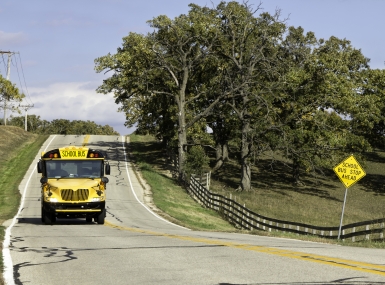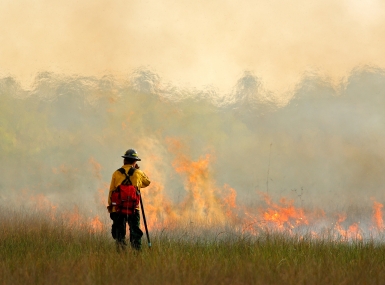Infrastructure law boosts public lands wildfire arsenal
Key Takeaways
The U.S. Forest Service is changing its approach to combating wildfires, choosing a method commensurate with the growing size of the threat. At the same time, the investments made by the Bipartisan Infrastructure Law is having a substantial impact on the Forest Service’s and Department of Interior’s approaches before, during and after wildland fires.
During a summit on public lands management and wildfires during NACo’s Legislative Conference, Forest Service Chief Randy Moore said the agency is adjusting to the growing scope of wildfires.
“Our process has been to do what we call ‘random acts of restoration,’” he said.
Learn more
“We have taken the money that we get and we try and treat a lot of different areas, but what we’re seeing is that the level and the scale of treatment that we’re providing on the landscape does not match the levels and scale the fires and the disease and insects that are taking place on the landscape.”
The Forest Service has added 11 additional landscapes to the 10 designated high-risk firesheds that were identified in 2022, on which hazardous fuel removal is prioritized.
“Our scientists are telling us that if we’re able to treat anywhere between 20–40 percent of a fireshed, then we would have a positive outcome on how fire behaves when it moves across that landscapes,” Moore said.
Jeff Rupert, director of the Department of Interior’s Office of Wildland Fire, reported that the department reduced hazardous fuels on 2 million acres of its land, with another 800,000 acres planned in 2023.
“It really is about bringing a priority focus on where you’re treating acres, how you’re partnering to treat acres at that broader scale, that landscape scale, that watershed scale and developing shared strategies to reduce that risk working at the county level working with local communities working with other federal partners, tribes so that it’s not just about ‘OK, what is our plan on a particular interior administered piece of land?’ but really what is that shared strategy to reduce risk at a scale that makes a difference?” Rupert said.
In addition, the Interior Department completed more than 360,000 acres of post fire emergency stabilization and burned area rehabilitation in 2022.
Staffing concerns
The Bipartisan Infrastructure Law directed the Interior Department to increase federal land firefighter fighter pay, and Rupert said the department was eyeing a long-term strategy to make those raises permanent. The employee classification for wildland firefighters will likely change, too.
“That’s really important because that’s a fundamental part of how we think about addressing the challenge… around recruiting and retaining wildland firefighters,” he said.
“Firefighters want to be recognized as professional wildland firefighters,” and changes with the Office of Personnel Management can give them that recognition.
“We’re addressing you know sort of all of the qualifications and establishing clear lines of career development so that when someone enters the workforce as an entry level firefighter, they have a clear path to becoming a senior manager and see a full career in front of them.”
For an agency that deals mostly in what is essentially fuel for wildfires, any position contributes in some way to forest health or operation.
The Forest Service has seen a reduction of roughly 8,000 non-fire employees over the last 20 years, Moore said, and although he doesn’t think it will be possible to get back to that employment level, he did see a path to hiring 4,000 and leveraging the other half through partnerships, including working with counties. But staffing is a dynamic challenge.
“We hired 3,300 new employees last year and that was really good it was getting that increasing the capacity, but then we lost 2,500 through attrition and so what we really only gained was about 800 new people to add to the capacity,” he said.
“When you look at the entry-level type-positions, then there’s an amount of time where you need to be training people as well, and so the other thing that we’ve noticed is that a lot of the people we’ve hired in the last three years a high percentage of them have left the agency,” he noted.
“We are experiencing a 45 percent reduction of the new people that we brought on that have left.”
Attachments
Related News

Secure Rural Schools Reauthorization Act of 2025 signed into law in victory for counties
On December 18, 2025, President Trump signed the Secure Rural Schools Reauthorization Act of 2025 (P.L. 119-58) into law. The reauthorization of the SRS program is a major victory for counties and ensures that timber-dependent counties will receive critical funding to maintain essential local government services such as public education and transportation infrastructure.

DOI announces creation of new U.S. Wildland Fire Service
On September 15, the U.S. Departments of the Interior (DOI) and Agriculture (USDA) announced major joint directives to change how the agencies will coordinate and provide wildfire response, including the creation of a new U.S. Wildland Fire Service within Interior.

U.S. House of Representatives passes SPEED Act and other permitting reform bills
On December 18, the U.S. House of Representatives passed the SPEED Act (H.R. 4776). The SPEED Act would strengthen county involvement in decision-making and make needed commonsense reforms to the federal environmental review process.
